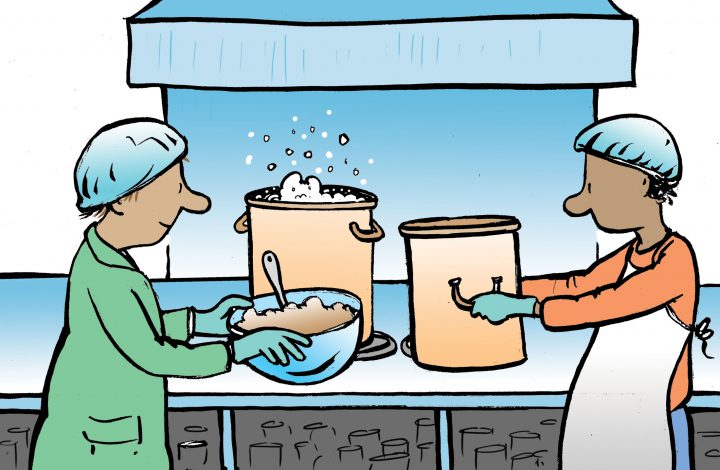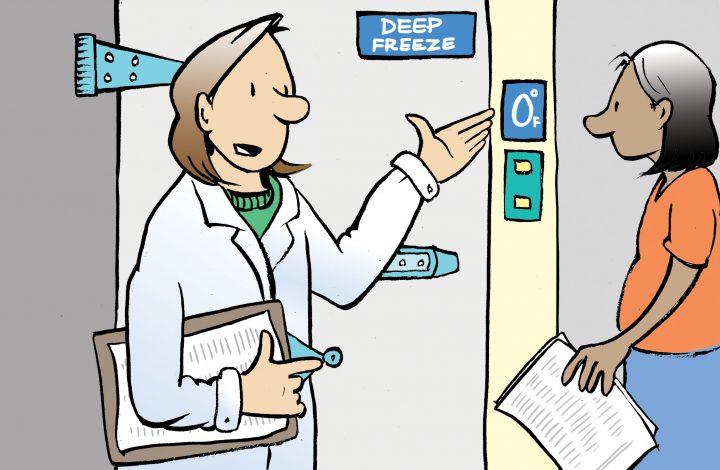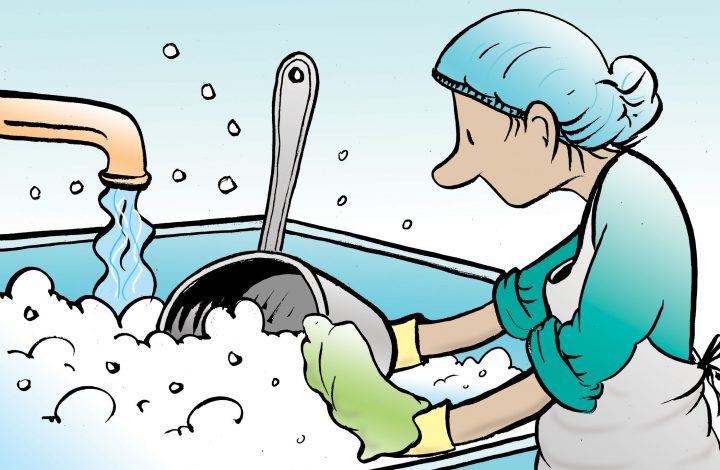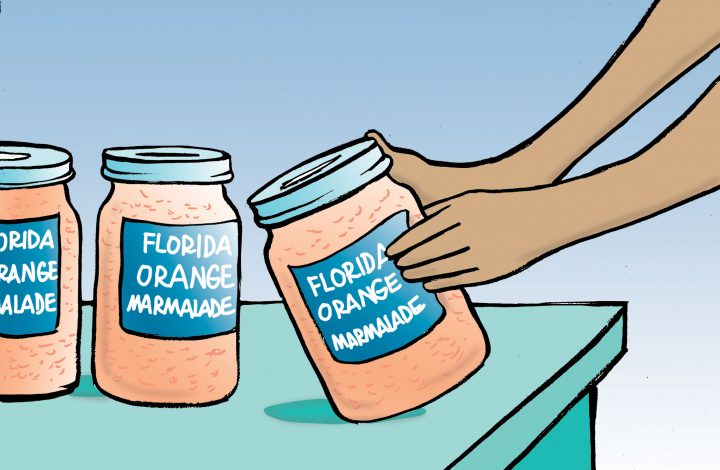Cleaning and Sanitation play a key role in the protection of food products from contaminants such as bacteria, viruses, insects, pests, and other biological hazards.
Cleaning versus Sanitizing
Cleaning is the process of removing contamination from food preparation surfaces such as counters, cutting boards, dishes, knives, utensils, pots, and pans. Cleaning comes before sanitizing in food preparation. The three steps of the cleaning process are:
Step One: Wash with detergent and warm water
Step Two: Rinse with clean water
Step Three: Rinse if necessary. Air dry or dry with a clean paper towel
Sanitizing involves the use of an active agent such as a commercial sanitizer, bleach, hydrogen peroxide, or vinegar to kill living organisms. Similar to cleaning, sanitizing is a three-step process. Most often, sanitizer remains on the surface for a designated time in order to kill the biological contaminant. Some sanitizers, though, require rinsing. Always ensure that the sanitizer used is labeled for use on a food contact surface.
Step One: Spray or immerse surface with sanitizer
Step Two: Leave sanitizer on surface for designated time
Step Three: Air dry or dry with a clean paper towel after designated time has elapsed
To learn about designated sit-times for specific sanitizers, visit UF IFAS: Cleaning & Sanitizing the Kitchen
Creating a Sanitation Standard Operating Procedures (SSOP)
Sanitation Standard Operating Procedures (SSOP) refers to a written document used in a food business that describes specific methods that are designed to prevent the introduction of harmful hazards by maintaining clean and sanitary production environments. The SSOP provides instructions to ensure adequate cleaning and sanitizing of equipment and surfaces that come in contact with food, and most state regulatory agencies require a food business to provide SSOP documents during inspection for permitting and licensing.
A company SSOP can be as simple as a collection of standalone documents explaining sanitation procedures, and the documents should also serve as instructions for staff and employees to follow during food handling and preparation to avoid cross-contamination. Cross-contamination is the process by which a hazard, such as bacteria, is unintentionally transferred to a food or surface via contact with contaminated surfaces, tools, hands, and/or products.
The SSOP is designed to prevent the spread of hazards by cleaning and sanitization at specific locations and/or points in the production process. SSOPs can range from very simple to extremely complex depending on the needs of the food operation, because they should address the unique production activities conducted by the food operation.
In most cases, a simple SSOP should at least include:
-
- Equipment and surfaces to be cleaned (including hands)
- Supplies to clean equipment and surfaces
- Methods to disassemble equipment if necessary
- Methods to cleaning and sanitize
- Frequency of cleaning and sanitation
**Be sure to create a process for recording when this process occurs
Designing a simple SSOP begins with three basic steps:
Step One: List each product produced by the business and create a flow diagram of the production process. Identify all surfaces and equipment used in production.
Step Two: Identify areas and procedures where cross-contamination can take place. Some examples include handling and chopping vegetables, combining ingredients with a mixer, serving soup with a spoon, adding water to a pot, etc.
Step Three: Develop and document sanitation procedures that will prevent or eliminate the spread of hazards during the production process. This can include requiring employees to wash hands before handling products, using separate utensils or sanitizing utensils after each use, or sanitizing prep surfaces after each use.
Eight Key Areas of Sanitation for Florida Permitted Food Businesses
State regulatory agencies target eight keys areas of Sanitation during the inspection and permitting process, and these areas should be addressed in the SSOP
| Sanitation Area |
Description |
Example of SSOP |
| 1. Water |
All water used to to clean surfaces and equipment or prepare food (including ice) must be potable, or suitable for drinking |
- Documentation of water safety from water source such as utilities or routine testing of well water sources
|
| 2. Condition and cleanliness of food contact surfaces |
All surfaces, including hands and utensils, must be free from bacteria, pests, and other hazards |
- Routinely sanitize stainless steel counter tops, storage areas, equipment, dishes, and utensils
|
| 3. Prevention of cross-contamination |
All surfaces that come into contact with food must be free from bacteria, pests, and other hazards. This includes food packaging materials, utensils, gloves, outer garments, and raw products |
- Segregate raw, uncooked products from cooked products
|
| 4. Hand washing, hand sanitizing and toilet facilities |
Food handlers must adhere to basic personal hygiene practices to prevent the spread of disease |
- Posting hand-washing signs in restrooms
- Require food safety training
- Clean restrooms on a routine basis
|
| 5. Protection from adulterants |
Food, packaging material, and contact surfaces must be protected from chemicals such as fuel, pesticides, cleaning compounds, and sanitizing agents |
- Segregate chemicals in a separate storage area
- Keep all chemicals below food preparation areas
- Designate separate times for cleaning and food preparation
|
| 6. Proper labeling, storage and use of toxic chemicals |
All cleaning and sanitizing solutions should be labeled and stored according to their properties |
- Routinely check that all containers are properly labelled
|
| 7. Control of employee health conditions |
Employees diagnosed with or displaying symptoms of certain illnesses that might result in the microbiological contamination of food, food packaging materials and food contact surfaces must be removed from food preparation |
- Train employees on specific illnesses that contaminate food
- Implement policies that allows employees to miss work due to illness
|
| 8. Exclusion of pests |
Food areas must be free of all pests such as insects, rodents, and pets as well as droppings, parts and hair |
- Install wire mesh in building gaps to prevent rodent entry
- Routinely apply pesticide during non-operating hours
- Conduct routine inspections for pests
|
Common Procedures in an SSOP include but are not limited to:
-
- A program to routinely train, monitor and correct employee knowledge and practice in sanitation and cleaning procedures (For more information visit the Food Safety Training guide)
- Record-keeping to document sanitation practices such as cleaning bathrooms, sanitizier storage, pest control application, and grease trap cleaning
- Routine testing and inspection such as testing sanitizer strength and reviewing expiration dates on stored ingredients
- Evaluating kitchen design to enhance production and cleaning systems
- Appropriate storage and labeling of ingredients as well as products in storage (for more information, visit the Packaging & Labeling guide)
- Food handling protocols that include segregated prep areas and equipment for potentially hazardous foods such as meat and seafood, handwashing criteria, gloves, hairnets, aprons, and other protection preventing the introduction or cross-contamination of hazards (for more information, visit the Packaging & Labeling guide)
- Temperature regulations in refrigerators, freezers, warmers, and heaters
SSOP and Your Farmers’ Market Business
The SSOP not only safeguards the consumer, but it will also protect the farmers’ market business from accidentally producing and selling food that is harmful to customers. Depending on the product, some food businesses processing certain potentially hazardous foods (such as meat, seafood, juice, and others) are required to implement an additional FSPC and/or HACCP plan.
This plan goes into greater detail by analyzing the production process, identifying critical areas where hazards can enter production and developing procedures to prevent, monitor and document procedures to control the process. For more topics and information related to sanitation, review the resources below, and visit the Food Safety Training and Regulatory Agencies guides on this website.





